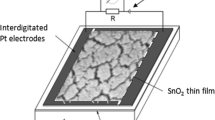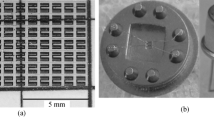Abstract
Thin films of SnO2 were prepared by the radio frequency (13.56 MHz) sputtering technique in a wide range of oxygen/argon concentrations within the sputtering system. The films were analyzed by means of transmission and scanning electron microscopy, x-ray diffractometry and Auger electron spectroscopy. The results showed the films to be polycrystalline with an average grain size of 400 Å. Room temperature resistances of as-sputtered films showed a strong dependence on the oxygen concentration in the sputtering environment. Electrical conductivity studies of these films in oxygen and in hydrogen revealed the fundamental charge transfer mechanisms in the observed gas sensitivity of the material to be due to an interaction of the hydrogen with chemisorbed oxygen ions on the semiconductor surface. Finally, a means of providing selectivity between H2S and H2 responses was studied.
Similar content being viewed by others
References
A.G. Jordan, “Studies of Semiconducting Metal Oxides in Conjunction with Silicon for Solid State Gas Sensors”, CMU Proposal No. 08180 and ERDA Contract No. EE-77-S-02-4346 (1976).
G.N. Advani, Y. Komen, A.G. Jordan, D.J. Leary and R.L. Longini, “Studies of SnO2 as a Material for Gas Detection”, presenation at the 153rd Meeting of The Electrochemical Society, Seattle, Washington, May 21– 26, 1978; Abstract No. 37.
A.G. Jordan, D.J. Leary, G.N. Advani and J.O. Barnes, “Studies of Semiconducting Metal Oxides in Conjunction with Silicon for Solid State Gas Sensors”, Invited talk at the Symposium of the Developemnt and Usage of Personal Exposure Monitors for Exposure and Health Effect Studies, January 22–24, 1979, Environmental Protection Agency, North Carolina.
M.G. Morgan and S.C. Morris, “Individual Air Pollution Monitors - An Assessment of National Research Needs”, Report of a workshop held at Brookhaven National Laboratory, Upton, NY, July 8–10 (1975).
Z.M. Jarzebski and J.P. Marton, J. Electrochem. Soc.123, 199C (1976).
M.F. Chung and L.H. Jenkins, Surf. Sci.22, 479 (1970).
A. Glassner, U.S. Atomic Energy Commission Report, ANL-5750 (1957) .
J.H. DeWit, J. Solid State Chem.8, 142 (1973).
P.B. Weisz, J. Chem. Phys.21, 1531 (1953).
M.J.D. Low, Chem, Rev,60, 267 (1960).
H.E. Matthews and E.E. Kohnke, J. Phys. Chem. Solids29, 653 (1968).
S. Roy Morrison, TheChemical Physics of Surfaces, Plenum Press (.1977) .
Author information
Authors and Affiliations
Rights and permissions
About this article
Cite this article
Advani, G.N., Jordan, A.G. Thin films of SnO2 as solid state gas sensors. J. Electron. Mater. 9, 29–49 (1980). https://doi.org/10.1007/BF02655213
Received:
Revised:
Issue Date:
DOI: https://doi.org/10.1007/BF02655213




